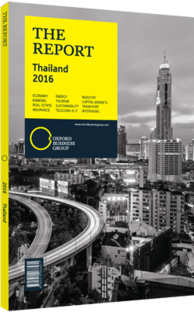Programmes to stabilise lending to SMEs in Thailand
Small and medium-sized enterprises (SMEs) comprise a significant proportion of Thailand’s economic base and are critical for ongoing economic diversification, making SME financing a government priority. However, commercial SME lending in Thailand is expected to slow in 2016, as the ratio of non-performing loans (NPLs) rises against a backdrop of slowing economic growth. Recognising this, the Ministry of Finance (MoF) and Ministry of Commerce (MoC) have rolled out new SME finance programmes in recent years.
Considerable Significance
SMEs contributed BT5.21trn ($156.8bn), or 39.6% of GDP, to the Thai economy in 2014, according to the Office of SME Promotion (OSMEP), and despite their GDP contribution rising just 0.2% in 2014, compared to 3.5% in 2013, SMEs remain an economic pillar in the country. OSMEP reported that there were 2.74m SMEs at the end of 2014, representing 99.73% of total businesses, while the state-owned SME Bank estimates there are likely closer to 15m in total, the majority of which are unregistered. SMEs additionally accounted for 80.3% of total employment in 2014, according to OSMEP.
SME lending is also significant for Thailand’s financial services sector, comprising 38.4% of total commercial bank loans in 2015, according to the Bank of Thailand (BOT). The BOT reported that SME lending grew from 3.4% in 2014 to 5.6% in 2015, while Deloitte reported that SME loan volumes recorded a compound annual growth rate of 12% between 2011 and 2014 to reach $171bn from $133bn in 2011.
Challenges
A 2015 Deloitte report titled, “Digital banking for SMEs – Improving access to finance for the underserved”, found that less than 60% of SMEs in Indonesia, Malaysia, the Philippines, Singapore and Thailand have access to bank loans, while 50% are unserved or underserved by financial institutions. Although Thailand led the five countries in terms of SME lending, Deloitte reported that Thai SMEs continue to face challenges in accessing credit. These included a lack of information and advice from financial institutions, a high degree of complexity related to the loan application process, high fees and interest rates, and lack of collateral. “One of the main obstacles for SME lending is the lack of data available on these businesses,” Nasha Ananchotikul, head of the BOT’s Macroeconomic Forecasting Team, told OBG. “Banks are reluctant to lend because they don’t know the history of the potential borrower, and in a risk-averse environment the problem is exacerbated.”
According to the BOT, SME NPLs rose 19.8% in 2015, from BT137.9bn ($4.2bn) in 2014 to BT165.2bn ($5bn) in 2015, and an NPL ratio of 3.5% in Q4 2015. This is compared to a ratio of 2.56% for consumer loans, 1.61% for corporate loans and an overall NPL ratio of 2.55%. “NPLs are still rising and likely to continue into the second half of 2016, partly due to sluggish economic recovery, drought and previously restructured loans relapsing into NPLs. Banks will therefore need to keep provisioning high, and we will see the effects of this on SME loans in 2016,” Kritapas Siripassorn, research analyst at Citibank, told OBG.
Government Support
The government has introduced a number of new programmes aimed at supporting SMEs, which should help stabilise lending and NPLs over the medium term. These include the Business Security Act of April 2015, which will enable better access to funding by using existing assets as collateral, and financial assistance, largely in the form of soft loans. In January 2016, the Government Savings Bank and Stock Exchange of Thailand announced plans to establish an SME Private Equity Trust Fund to provide low-interest loans for working capital.
The MoF is also ramping up credit assistance programmes through a two-pronged support strategy comprised of financial assistance and a supportive tax policy. Within the financial assistance pillar, supportive mechanisms include a low-interest loan scheme, guarantee initiative and venture capital fund.
You have reached the limit of premium articles you can view for free.
Choose from the options below to purchase print or digital editions of our Reports. You can also purchase a website subscription giving you unlimited access to all of our Reports online for 12 months.
If you have already purchased this Report or have a website subscription, please login to continue.

